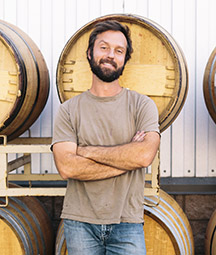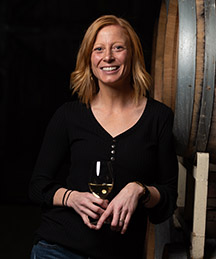There are many ways to create red Bordeaux-style blends. Three American winemakers share their approach to making massively complex, high-end wines.
Matt Dees is the Winemaker at Jonata Winery in Lompoc, California

At Jonata we grow Cabernet Franc, Cabernet Sauvignon, Merlot, and Petit Verdot. We also farm a small parcel planted to an incredibly unique Cabernet Franc clone that I’m pretty sure is something completely different . . . as if Petit Verdot and Merlot had a love child. A crazy love child. Maybe we’ll name it Petit Franc or something silly like that, but it sure as hell seems different. Massive tannin, black fruit, and an intense, incense character.
Speaking specifically of the wine regions in Santa Barbara County, our winegrowing benefits from an unusual geological feature. We have a spine of mountains that actually runs east/west as opposed to the usual north/south orientation in a majority of North America (think Rockies and Sierras). Due to this, we get all of our climatic influence from the west coast of the county as opposed to the south coast of the county. This all sounds like boring minutiae until you realize the temperature difference between these coasts: One is driven by a current running down the coast from Alaska and the other is driven by a current sent up from Mexico. As a result of this unique confluence of factors, the wine regions of Santa Barbara are far cooler (and sometimes downright chillier) than one would imagine for a southern California locale.
Ballard Canyon AVA sits far enough from this cold ocean to achieve high daytime inland temperatures. At the same time, it is still close enough to the coast to benefit from its vast cooling capacity. We see a giant diurnal shift during the growing season that allows the grapes to ripen fully, but also maintain a high level of natural acidity. The cool nighttime temperatures also help to maintain some of the latent herbal nuances of this special family of grape varieties. I’ve always found Bordeaux variety-based wines devoid of this herbal “coolness” to be rather lacking in spirit and sincerity.
Finally, Jonata has its own distinct soil composition of Careaga sand, which accumulated 5.3 million years ago as the hills began their emergence from the Pacific Ocean. The sand has a unique ability to lock in moisture while also providing excellent drainage. Based in this soil, it is also fairly disease-resistant. Through careful irrigation, we can control vigor and farm in a way that encourages vines to dig deep into the earth. All of this has allowed for the planting of own rooted, head trained Cabernet Sauvignon.
The true beauty (and challenge) of winegrowing is that nothing is ever stagnant for long. We see vastly different conditions from growing season to growing season. For example, sometimes our Cabernet Franc gets the right amount of heat at the right moment to gain the perfect depth and richness. In some cooler years it barely achieves this balance. In these years we will often utilize some later picked Merlot for density and roundness and to support the elegant and complex nature of Franc.
I can’t say that I have a favorite as I truly love them all. Cabernet Sauvignon is definitely the most complete and consistent. It is, in many ways, the most noble. That being said, in any given year I’ve seen Cabernet Franc, Merlot and/or Petit Verdot give Cabernet Sauvignon a ride for its money.
They all have charming quirks. Merlot requires older vines and needs a good set in the vineyard to produce balanced wines. Cabernet Franc needs a little bit of luck and some vintage magic to reach its truly remarkable potential, but when it gets there, it’s the best. Hands down. Similarly, when Petit Verdot can hang long enough on the vine it can shock the world with its unexpected charm, balance, and ultimate grace.
When it comes to fermentation, we tend to use cultured yeast for our Bordeaux varieties. We often see rather low YAN (yeast assimilable nitrogen) numbers combined with moderate Brix levels (potential alcohols of 13.7–14.9%), so on occasion relying on the native flora and fauna in our vineyard/facility can be a bit of a dicey plan. With latent yeast in Pinot Noir and Chardonnay, we don’t see an issue (lower pH and most often a lower Brix level) but with Bordeaux varieties we prefer to use RP15 yeast for most ferments. It gives us consistently dry wines with low volatile acidity (VA) and no issues with reduction. It also allows us to shift gears immediately into malolactic (ML) ferment immediately after completion of primary with no issues. We also occasionally utilize different yeast on smaller ferments for further complexity in future blending. For example we have been experimenting with Alchemy IV in Merlot. It is a bit much on its own with loud notes of black licorice and powerful black fruit, but adds incredible dimensions when blended back later in the cellar.
We use only French oak with our Bordeaux varieties and actually with all of our wines in the cellar. It’s not that French oak is necessarily better, but we prefer the structural and textural impact from this oak more than American oak. Over the past few decades I have worked hard to focus on a handful of cooperages that are consistent and whose barrels support our wines instead of leaving a heavy mark on them. I now like a mix of medium and medium-plus toasted barrels, most often (not always, depending on cooper and forest) with 36 month dried wood. Every cooper is different in their terminology and their use of fire in toasting. They all react differently and we use a few barrels that express early in the ageing, but a majority of our cooper partners produce barrels that take about 12–16 months to fully integrate. I find that many people focus on the wrong part of the relationship between oak and wine: The early aromatic and flavor contributions of oak. While I would never say this is of no consequence, I find so much more lasting contribution to wines in the structural and overall textural contributions of wood.
Most of our blending is done post-fermentation, usually the month before we bottle as we don’t often choose to rack our wines before 20 to 22 months. I like this timing for a number of reasons. The primary reason for this is a phenomenon we saw in the primeval Jonata days where our favorite fermentation lots from our initial vintage review tasted at 3 to 6 months post-harvest were almost always our least favorite lots at our final tasting prior to bottling at 18 to 24 months. The showy and flashy lots that shine early often fade and a blend made at 3 to 6 months (at least with wines from our unique properties) would ultimately be very underwhelming. In my experience, the tighter (often less expressive), better balanced and more structurally sound wines tend to prevail in the long run and they often take months and years to truly understand in size, shape, and magnitude. In essence, I now prefer to wait until the wine lot is completely expressed prior to blending it.
That being said, my team and I have now farmed the properties for 19 vintages so we are aware of some relationships between grape varieties and amongst specific vineyard parcels that can be rather symbiotic. For example, we do harvest and co-ferment some (later picked) Merlot with some of our best Cabernet Franc and Cabernet Sauvignon blocks. Similarly, in some warmer vintages we will co-ferment a small amount of Petit Verdot with Cabernet Sauvignon for added complexity and structure.
The blending process, especially with Bordeaux varieties, is always a welcome challenge. In the case of these blends there is a sharp divide between consumers who demand a wine that is going to be delicious when they open it (and don’t decant it) a few months after it is released and those who purchase the wine on release and expect it to be vibrant, delicious, and perfectly evolved at 25 years of age. This is not an easy task for winemakers. As they say, you can’t please all of the people all of the time. With that said, we work very hard to build wine blends to satisfy early with their generous and deep fruit, but primarily we focus on building a wine with structural integrity and overall freshness. For me these wines absolutely require a VERY high quantity of VERY high quality tannins. Without this backbone, the wines will always fall apart. It is also of the utmost importance to realize that structure without supporting fruit weight is also doomed to fail from imbalance. Oh, the joys of blending!
When it comes to specific advice for home winemakers I’m afraid to give too many tips based on what we see here in our little corner of Santa Barbara County because grapes are so different even between neighboring parcels. The one that I would give is to always welcome experimentation as these grapes never cease to surprise. For better oak integration with new barrels never underestimate the importance of high quality and clean lees. ML in barrel also aids in this early process of marriage between oak and wine. Ditto on pressing back to barrel with a small amount of fermentable sugar to finish the last degree or so in the wood. To this extent, knocking the head out of a barrel and fermenting directly in the wood is also often a pleasant surprise. There is so much nuance in these grapes. People often claim that Pinot Noir is the most difficult wine to produce . . . I have always disagreed. For me there is no greater challenge, nor great reward, than farming and producing beautiful and balanced Bordeaux varieties (Cabernet Franc, I’m specifically looking at you!). The most important thing to always remember is that you can only make fantastic wines from fantastic grapes. That is the key.
Daniel Daou is the Co-Proprietor and Winemaker of DAOU Family Estates in Paso Robles, California

Red Bordeaux varieties we grow on DAOU Mountain include Cabernet Sauvignon, Merlot, Cabernet Franc, Petit Verdot, and Malbec (Cabernet Sauvignon and Cabernet Franc have demonstrated to be the two varieties that reign supreme here). We have also started experimenting with Arinarnoa, which has been added to the red Bordeaux list in the last few years in small quantities. The terroir is what makes the location ideal for growing these varieties here. It’s a combination of European soils (calcareous soils), which are generally not found in California, and a perfect climate that benefits from a maritime influence combined with higher elevation.
We have isolated our own native yeast that we nicknamed D20. The number comes from being number 20 out of 100 native yeasts we investigated for years. It is now available worldwide to be purchased by other wineries (available from Enartis in large quantities) and has demonstrated that it has a better ability to finish fermentations all the way to dryness as well as having better stabilization of color, which leads to a better texture.
Whenever possible, we like to co-ferment our varieties. We feel that the integration works better in these cases. However, it depends on the year and the block we are working with. We cannot force this process. Generally, the main blending occurs after fermentation and right at spring racking following the harvests.
We use 100% French oak with all our wines. We have developed five custom French oak barrels working with top cooperages with a toast that is not intrusive on the wine. We see complexity develop in the wine as it ages in these barrels and incorporates beautiful subtle flavors accompanied by notes of vanilla, clove, and cigar box.
The goal of all of our blends is defined by tremendous elegance that is never sacrificed by power, which is what I would stress to home winemakers. The best advice I can give is to trust your palate. Never generate power at the expense of elegance. Let your wine be a work of art backed by science.
Sarah Hedges Goedhart is the Head Winemaker at Hedges Family Estates in Benton City, Washington

For Bordeaux varieties, we grow Cabernet Sauvignon, Merlot, Cabernet Franc, Petit Verdot, and Malbec, with first plantings of these vines being in 1990. Red Mountain is an ideal growing region for quite a few varieties. We do find Cabernet does especially well here and in some years Merlot and Cab Franc really shine. We have quite a lot of growing degree days most years and don’t really have an issue with pyrazines. Fruit gets consistently ripe with nice concentration due to a lot of UV exposure and minimal water. We also get a nice diurnal shift during the September/October harvest season, which helps to retain acidity and keeps textures balanced even in our warmer climate.
We are a biodynamic property and winery, so I do multiple picks of the same block to get balance within the varieties naturally. Early picks tend to be lighter and have more acidity, with redder fruit character and later picks tend to be a bit heavier and rounder with a different aroma profile. I utilize all of these picks to create a common theme to the blends each year, but they are never quite the same. I prefer to do blends post fermentation to really give each block a chance to shine and express itself. This gives me a chance to find the little nuances in all the varieties and blocks to really find layers of flavors. Even in our single varietal wines, we are blending different picks of blocks, different fermentation styles, and different vineyards; this gives us so many more primary, secondary and tertiary flavors to play around with. Since we do not add anything to the wines except organic yeast nutrients and SO2, we are at the whim of nature. Post fermentation blending gives me way more colors for my painting, so to speak.
We have used D254 yeast for years, but I have also liked the results from EC1118, and D21. Most of our production of estate fruit is now biodynamic and we do really like the complexity we get from the native ferments.
I like to use a mix of French, Hungarian, and American oak on our wines. For the Bordeaux varieties I do prefer to go heavier on French oak, especially for Cabernet Sauvignon. I will use some American and Hungarian on these as well. French really does integrate well with Bordeaux varieties, especially from Red Mountain. We have quite a bit of structure, concentration, and power here; French oak really rounds out and softens this to add some elegance to the final wines. Our new oak percentage is usually around 60%. In contrast our Syrah program is a bit more American heavy, but a much lower percentage of new oak, somewhere between 30–40%.
The Hedges style has always been staying true to the land, which is part of the reason we decided to go biodynamic in 2007. We believe wine is a reflection of place and time and embrace vintage variation, I spend a lot of my time winemaking out in the vineyard before we harvest anything. Our blending goals revolve around this philosophy. We don’t want to mask what nature gave us by using additives, so the goal in blending single varietal or multi-varietal wines is always to create balance with aromas, textures, and flavors. Each variety and lot will become an ingredient for this purpose, and I always ask myself, what is Red Mountain trying to tell me? I taste every lot monthly (we end up with about 100–120 different lots) and each new barrel annually and take notes and try to really get to know each wine and each barrel and what they are trying to express. With these notes I have an internal grading scale. These lots and scores end up on a very big spreadsheet and I use what we have done in the past as a starting point and go from there. It takes months to really understand the wines and figure out where each of them should go. It’s a daunting process, yet a very fun one each year!
And that would be my advice for home winemakers too: Really spend the time getting to know your wines. Pay attention to the nuances. Maybe one lot doesn’t have the best aromatics, but it has lively acid and a nice structure. Use the strength of each lot to your advantage and think about the big picture of what you are trying to accomplish. Definitely go with your gut instinct when it comes to pick dates (if you have this luxury), this is the most important for creating a balanced wine; picking the fruit when it’s ready will go a long way. Think about the style you are trying to achieve as well, picking for a style is much easier than trying to adjust a wine after picking. Using blending is the second component you have for stylistic success. If you like the aromas of later picked Cabernet, but it’s a bit flabby, then that’s where a Petit Verdot would fit in nicely. It’s amazing what 3% of something can do to really fine-tune a wine. In the end, make a wine you enjoy drinking!







